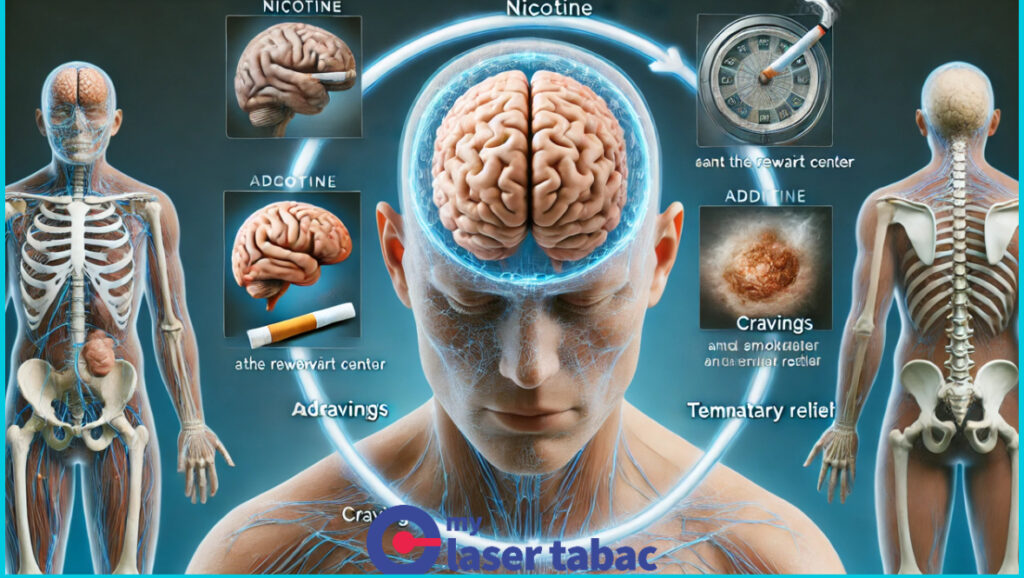Tobacco, a world-famous consumer product, comes from the Nicotiana tabacum plant, cultivated mainly for its leaves. These leaves are rich in nicotine, a substance that modifies brain activity, leading to addiction. Over the centuries, tobacco has become much more than a simple plant; it has influenced social, economic and health behaviors throughout the world.
Historically, tobacco consumption dates back to Native American civilizations, who used it in spiritual rituals. However, since its introduction to Europe in the 16th century, tobacco has evolved into a massive industry, transforming the habit into a truly global addiction. Consumption takes place mainly in the form of cigarettes, although other variants such as cigars, chewing tobacco and electronic cigarettes also exist.
Why do we smoke? Addiction at the heart of smoking
At the heart of tobacco addiction lies nicotine. This chemical compound acts directly on the brain by releasing dopamine, a neurotransmitter responsible for sensations of pleasure. This physiological response reinforces the desire to continue smoking, creating an addiction. It’s this effect that makes tobacco hard to give up, despite the many health hazards it represents.

Health hazards: a global scourge
Tobacco consumption is one of the world’s leading causes of preventable disease. It is responsible for numerous pathologies, including some of the most serious. Among these harmful effects, the risk of cancer is undoubtedly the best known, and with good reason: smoking considerably increases the risk of cancer, particularly of the lung, throat and mouth.
In addition to cancers, smoking has a severe impact on the cardiovascular system, increasing the risk of heart disease and stroke. Breathing, too, suffers: cigarette smokers often develop chronic lung diseases such as chronic bronchitis and emphysema, conditions that limit respiratory capacity and reduce quality of life in both men and women.
The effects of passive smoking should not be underestimated. The WHO (World Health Organization) has repeatedly warned that non-smokers exposed to tobacco smoke run risks similar to those of smokers themselves. In France, for example, studies have shown that thousands of deaths every year are linked to passive smoking.
The anti-smoking laser: a valuable aid in quitting smoking
Faced with these dangers, many people are looking for ways to free themselves from tobacco dependency. Among these options, anti-smoking laser therapy stands out as an innovative and effective solution. This treatment is based on auriculotherapy, a technique that involves stimulating specific points on the auricle with a gentle laser.
The use of lasers in this context acts as a trigger for tobacco detoxification, relieving withdrawal symptoms and reducing cravings. Unlike other methods, this treatment does not involve chemicals or nicotine substitutes. What’s more, its high success rate makes it a preferred option for smokers determined to quit. In just one session, nicotine dependency can be significantly reduced.
The effects of smoking on breathing: an asphyxiated respiratory system
The effects of tobacco on breathing are among the most striking and visible. From the very first puff, the toxic substances contained in cigarette smoke, such as carbon monoxide and tar, penetrate the lungs. These substances reduce the capacity of the lungs to absorb oxygen, making breathing less efficient.
Over the years, regular smokers begin to feel the effects: shortness of breath on the slightest exertion, persistent coughing, frequent respiratory infections. These symptoms are harbingers of serious respiratory diseases, such as chronic obstructive pulmonary disease (COPD). In this pathology, the airways become progressively obstructed, leading to a constant sensation of suffocation.
Tobacco and its global impact: a public health crisis
Beyond its personal impact, smoking has become a genuine public health crisis. Worldwide, the WHO estimates that tobacco kills more than 8 million people every year, a figure that includes the effects of passive smoking. In countries like France, despite prevention campaigns and restrictions on advertising and consumption in public places, smoking remains a major health problem.
This phenomenon is all the more worrying given that smoking affects adults and young people alike. The appeal of cigarettes to young people is often linked to social and cultural factors, such as group pressure, the desire to be like the others, or the search for a “cool” image. If left unchecked, this phenomenon can lead to dependence from an early age, with serious consequences for health over the years.
The tobacco industry, for its part, continues to exploit marketing strategies to attract new consumers and maintain its base of followers. Despite the progress made in reducing tobacco consumption, developing countries, where awareness campaigns are less intensive, are under strong pressure from the industry. In addition, control measures such as price increases are not always implemented, making the fight against smoking even more complex.

Nicotine’s effect on the brain and body: the addiction loop
Tobacco addiction is largely explained by the effects of nicotine, which has a direct influence on the brain. When a cigarette is smoked, nicotine reaches the brain in less than 10 seconds, triggering a rapid release of the pleasure hormone dopamine. This release creates a sensation of satisfaction, but it is short-lived, prompting the smoker to consume more to recapture this effect.
Physical dependence manifests itself as withdrawal symptoms when a person tries to quit. These symptoms include irritability, anxiety, sleep disturbances and a feeling of nervousness. They are the result of the brain’s adaptation to the constant presence of nicotine. The addiction is such that the smoker eventually develops a tolerance, requiring an ever-increasing quantity of nicotine to obtain the same sensations.
What’s more, tobacco addiction is not just physical; it’s also psychological. For many smokers, cigarettes become a kind of ritual associated with certain daily activities: morning coffee, breaks at work, or moments of stress. It’s this mental association that further complicates the smoking cessation process.
Methods for quitting smoking: from smoking cessation to alternative therapies
Quitting smoking is a challenge, but there are a number of methods available to help smokers along the way. Smoking cessation can be achieved with or without nicotine replacement products. Gums, patches and lozenges provide a reduced, controlled dose of nicotine, helping to gradually reduce physical dependence.
In addition, other non-nicotine methods, such as behavioral therapy, can be useful for working on habits and psychological triggers for smoking. This approach, which involves identifying and avoiding situations that encourage smoking, is often effective in breaking the mental link between cigarettes and certain habits.
How does the anti-smoking laser work to help stop smoking?
Among modern smoking cessation methods, the anti-smoking laser used at MyLaserTabac stands out for its effectiveness and simplicity. The process is based on auriculotherapy, an acupuncture-inspired technique involving the stimulation of reflex points on the auricle.
The auricular laser acts gently to help reduce smoking withdrawal symptoms. By stimulating specific points in the ear, it sends signals to the brain that help reduce cravings and alleviate the anxiety associated with nicotine withdrawal. Unlike methods based on nicotine substitutes, the laser does not add substances to the body. It is therefore a natural, non-invasive alternative for smokers wishing to break their addiction.
With a 90% success rate, this treatment is particularly effective, especially for those looking for a quick way to reduce their addiction in a single session. What’s more, this process doesn’t just help you quit smoking: it’s also designed to reduce the compulsive cravings that often follow smoking cessation, a common problem among ex-smokers.
The effects of smoking on breathing: progressive but irreversible damage
Tobacco has devastating effects on the respiratory tract. Cigarette smoke, laden with toxic substances such as tar, carbon monoxide and various chemicals, enters the lungs with each inhalation. This toxic mixture gradually damages lung cells, leading to chronic inflammation of the airways.
In the long term, smokers risk developing chronic respiratory diseases such as chronic obstructive pulmonary disease (COPD) and emphysema. These conditions reduce lung capacity, making breathing difficult and causing constant breathlessness. They are often irreversible and can considerably impair quality of life, even leading to oxygen dependency.
Reduced lung efficiency also has an impact on the cardiovascular system, as the lungs are no longer able to oxygenate the blood properly. This can lead to heart disease, such as hypertension, and increases the risk of myocardial infarction.
The challenges of quitting smoking: an investment in health and well-being
Quitting smoking is more than just a decision; it’s a commitment to a healthier life. The health benefits appear quickly after quitting. In just a few days, carbon monoxide levels in the blood decrease, allowing cells to be better oxygenated. After a few weeks, blood circulation improves and lung function begins to regenerate.
On a psychological level, quitting smoking breaks the addiction and frees you from the constraints associated with smoking, such as the constant need to find a place to smoke. It’s also a significant financial gain: with tobacco prices rising steadily, quitting smoking represents a substantial saving.
Conclusion: Smoking, a choice with many consequences and possible withdrawal
More than just a habit, tobacco is an addiction with serious health consequences. Fortunately, there are effective ways of breaking the habit. Becoming aware of the dangers of smoking is the first step towards quitting for good. Weaning methods, such as the anti-smoking laser offered by MyLaserTabac, offer solutions tailored to the needs of smokers.
By making more informed health choices, smokers can regain control of their lives and choose to invest in their well-being. Whether it’s a question of preserving your health, breathing easier again or reducing your risk of cancer, quitting smoking is an essential step for yourself and those around you.







